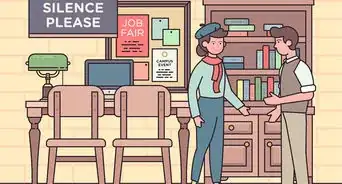wikiHow is a “wiki,” similar to Wikipedia, which means that many of our articles are co-written by multiple authors. To create this article, 9 people, some anonymous, worked to edit and improve it over time.
wikiHow marks an article as reader-approved once it receives enough positive feedback. In this case, 96% of readers who voted found the article helpful, earning it our reader-approved status.
This article has been viewed 45,934 times.
Learn more...
Career resource centers offer an environment for people to investigate different jobs, find the appropriate training or education, and develop the necessary skills for the workforce. Learn how to develop a career resource center that meets the needs of your clients so that you can empower these individuals to pursue careers that energize and fulfill them.
Steps
-
1Determine the venue of your career resource center. Resource centers can be available as an entire organization dedicated to assisting people with career and educational choices. Or, they can be smaller settings within organizations like businesses, colleges, and employment centers.
- The location will influence the type and amount of resources you are able to provide, as well as the clients you will typically serve.
-
2Compile career resources for others to access in your career resource center library. Career resources include articles, books, and other resources about searching for a job, career planning, setting and achieving career goals, and writing resumes. Start with foundational resources and build your library up from there. Focus on resources for your target audience.
- In a college or university setting, career centers should focus on resources that will help students identify a career to pursue, get the education or training they need to get that job, and then develop the skills they need to get hired.
- In a business setting, career resource centers can point to opportunities for further education and training. For example, personal growth classes, self-study programs, and GED, advanced certifications, and other degree programs.
- In an employment center, resource centers may help adults transition between one career to another. This may be a voluntary transition or a forced one. Either way, resources that help adults make that switch will help them identify life goals, find educational opportunities that fit their lifestyle and personality, and locate potential jobs in their new field.
Advertisement -
3Develop programming. Workshops and classes offer groups of people to learn in a cost-effective way, which is important for someone looking for a job. Teach basic resume writing skills in a group setting, introducing different industries to consider entering, and offering interview tips.
- Tailor these workshops to things specific to your local community. For example, if your town hosts one or two major industries, offer classes or workshops that give individuals an inside look at what these industries do, how many employees are involved, and what those employees do.
- Schedule these with other events in mind. For example, if there is a job fair every spring, help your clients prepare by teaching a series of workshops on resume writing and interview skills. Use examples specific to the job fair environment.
-
4Network with other organizations. It is important for career centers to build and maintain positive relationships with other businesses and organizations, both on a local and national level. By maintaining these relationships, you will be able to quickly and confidently connect your clients with someone who can help them in their specific need.
- Partner with local businesses that hire frequently or in large numbers.
- Be familiar with national agencies that provide a wide range of resources your career center may not be able to offer.
- Connect with counseling centers that can provide career counseling.
- Have contacts with colleges and universities that offer training programs designed for specific industries.
-
5Incorporate one-on-one interaction. Though some individuals may be able to navigate through a career resource center alone, many others are seeking the advice and guidance of a more knowledgeable individual. They need someone to point them toward resources they have not been able to find on their own, help them interpret their self-assessment results, or develop their career goals.
- One-on-one writing sessions allow clients to talk to a staff member about their resume and what they can do to improve it.
- Practice interviews help clients prepare for the real interview in a way that a workshop on interview skills cannot.
- Career counseling provides clients with the opportunity to explore different passions and job opportunities related to those passions.
-
6Establish a web presence. This will help you reach out to people in your community before they even enter your career center. It will also provide extra resources and support while clients are at home or seeking a different job on their own.
- Create a website for your career resource center. Provide basic information about your career resource center, such as address, business hours, staff members, and contact information. Explain what your center can do to help people find a job or develop specific skills.
- Use social media and blogs. These provide a more informal way to connect with clients and potential clients. It also offers you an opportunity to share general job-searching tips, announce upcoming workshops or classes, and see what people are talking about as it relates to careers.
- Offer an online chat system if you have the staff to support it. This allows shy individuals or those without transportation to talk with staff members and get their questions answered.
References
- Borchard, David C. "The Future High-Tech Career Center." Futurist May/Jun 2000: 22-28.
- Moir, Elizabeth. "Career Resource Centers in Business and Industry." Training & Development Journal, Feb 1981: 54-57.
- Sampson Jr., James P. "Integrating Internet-based distance guidance with services provided in career centers." Career Development Quarterly, Mar 1999: 243-254.
- Jaffe, Martin E. "A Career Center Model: 27 Years at InfoPlace." American Libraries, Jun/Jul 2003: 65-66.
- Taylor, Sandra C. "Workshop to Orient Students to Career Planning Services." Career Development Quarterly, Mar 1997: 293-296.
- http://www.asse.org/professionalaffairs-new/career-res/


































































